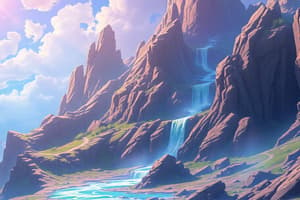Podcast
Questions and Answers
What is the primary composition of the outer core?
What is the primary composition of the outer core?
- Liquid iron-nickel alloy (correct)
- Solid iron and nickel
- Magnesium oxide
- Silicate minerals
What happens to S-waves at the Gutenberg Discontinuity?
What happens to S-waves at the Gutenberg Discontinuity?
- They transform into P-waves
- They cannot travel through the region (correct)
- They become absorbed completely
- They speed up significantly
Which layer of the Earth is characterized by a solid composition and high density?
Which layer of the Earth is characterized by a solid composition and high density?
- Outer core
- Mantle
- Inner core (correct)
- Crust
Who discovered the Mohorovicic Discontinuity and when?
Who discovered the Mohorovicic Discontinuity and when?
What is the average depth of the Mohorovicic Discontinuity under the continental crust?
What is the average depth of the Mohorovicic Discontinuity under the continental crust?
What defines the boundary separating the outer core and inner core?
What defines the boundary separating the outer core and inner core?
Which layer of the Earth is primarily composed of silicate materials?
Which layer of the Earth is primarily composed of silicate materials?
What layer of the Earth is solid yet located in a liquid environment?
What layer of the Earth is solid yet located in a liquid environment?
What characterizes the oceanic crust compared to the continental crust?
What characterizes the oceanic crust compared to the continental crust?
Which statement accurately describes the lithosphere?
Which statement accurately describes the lithosphere?
What distinguishes the upper mantle from the lower mantle?
What distinguishes the upper mantle from the lower mantle?
Which of the following accurately describes the core of the Earth?
Which of the following accurately describes the core of the Earth?
How thick is the mantle compared to the Earth’s total mass?
How thick is the mantle compared to the Earth’s total mass?
What mineral compositions does 'sima' represent in the oceanic crust?
What mineral compositions does 'sima' represent in the oceanic crust?
In which part of the mantle are rocks considered to be partially molten?
In which part of the mantle are rocks considered to be partially molten?
Which statement about the oceanic and continental crust is incorrect?
Which statement about the oceanic and continental crust is incorrect?
Flashcards are hidden until you start studying
Study Notes
Earth's Structure
- Earth consists of three major layers: Crust, Mantle, and Core.
Crust
- Outermost layer made of solid rocks and minerals.
- Two classifications:
- Oceanic Crust
- Extends 5 to 10 kilometers beneath the ocean floor.
- Composed of basalts; referred to as “sima” (silicate and magnesium).
- Dense and thin, formed at mid-ocean ridges.
- Continental Crust
- Composed mainly of granites, called “sial” (silicate and aluminum).
- Thickness can be over 70 kilometers; lighter than oceanic crust.
- Oceanic Crust
Mantle
- Lies beneath the crust, comprised of solid rock.
- Extends to a depth of about 2900 kilometers, contributing to 67% of Earth's total mass.
- Temperature and pressure increase with depth; heat transfer from the core raises temperatures.
- Divided into two layers:
- Upper Mantle
- Extends from the crust to about 410 kilometers.
- Mostly solid but malleable areas contribute to tectonic activity; includes the lithosphere (outer solid part).
- Lower Mantle
- Extends from about 660 to 2700 kilometers deep.
- Hotter and denser than the upper mantle; includes the asthenosphere (semi-molten layer).
- Mesosphere is the lowest part, adjacent to the outer core.
- Upper Mantle
Core
- Extremely hot and dense, located about 2900 kilometers below the surface.
- Composed of two parts:
- Outer Core
- Liquid iron-nickel alloy; temperature ranges from 4000 to 5000 degrees Celsius.
- Responsible for generating Earth’s magnetic field.
- Inner Core
- Composed mainly of dense iron and nickel; not affected by high temperature due to its pressure.
- Outer Core
Layer Division
- Chemical division based on composition: Crust, Mantle, Core.
- Mechanical division based on temperature and phase: Lithosphere, Asthenosphere, Outer Core, Inner Core.
Discontinuities
- Mohorovicic Discontinuity (Moho)
- Boundary between crust and mantle; average depth of 8 km under oceans and 32 km under continents.
- Gutenberg Discontinuity
- Boundary where P-waves slow down, indicating the presence of molten materials in the outer core.
- Lehmann Discontinuity
- Boundary between inner and outer core; supports the understanding of a solid inner core and liquid outer core based on seismic wave analysis.
Thickness Measurements
- Crust: Average thickness of 32 km.
- Mantle: Approximately 2853 kilometers thick.
- Core: Outer Core around 2270 kilometers; Inner Core about 1216 kilometers thick.
Tectonic Plates
- Massive slabs of solid rock that form Earth's outer shell, responsible for geological activities such as earthquakes and volcanic eruptions.
Studying That Suits You
Use AI to generate personalized quizzes and flashcards to suit your learning preferences.




